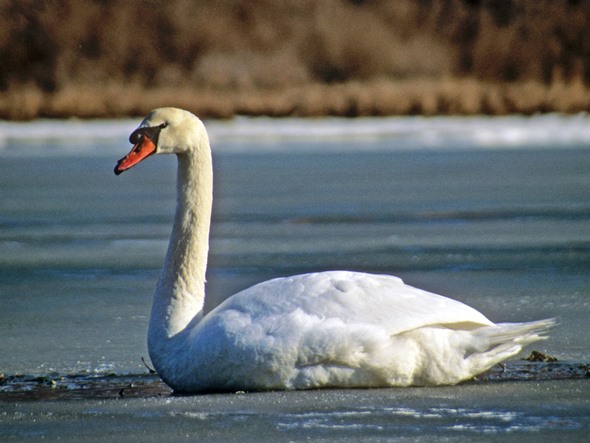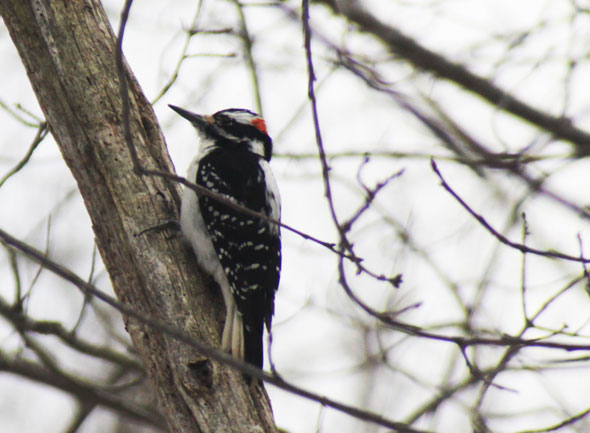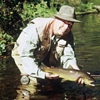WINTER COLD IS FOR THE BIRDS

Mute swans, like this one photographed on Hallock Bay in Orient, NY, feed on subaquatic vegetation and can eat up to eight pounds of sea grasses per day. Photo by Felicia Scocozza.
Bird watching in the dead of winter? Isn’t that usually a warm weather endeavor? Well, maybe for the casual backyard birder, but for those who head outside in search of anything from owls to hawks, mergansers to harlequins or even chickadees to nuthatches, winter is prime time.
“Birding is fantastic during the colder months,” said Mary Beth Tomko of Deer Park, who goes with her husband, Paul, every chance she gets. “I love the melodies, the colors, and just being outside. There’s a social aspect that’s fun, plus the thrill of the chase and the adrenaline rush of spotting a species you’ve never seen before.”
Wendy Murbach of Merrick agrees with Tomko, adding that, with all the different species, plumage variations, bird behaviors and calls, “you’ll never stop learning once you get serious.”
The best ways to get into birding, according to Syosset’s Stella Miller, president of the Huntington-Oyster Bay Audubon Society, are to take a group bird watching trip or join a local chapter of the Audubon Society. “Just being around experienced birders really cuts the learning curve,” Miller explained. “Veteran bird watches love to share their knowledge and can quickly teach you how to identify birds by both sight and sound.”

The hairy woodpecker is a common sighting in wooded areas during the winter months. Photo by Felicia Scocozza.
Dress Warm But Travel Light
Winter birding may be fun, but it is also cold. Dress in layers, starting with thermal undergarments, a warm shirt, sweater or sweatshirt, and a coat that will block the wind. Top it all off with a knit hat and scarf. A good pair of hiking boots are a plus, and absolutely necessary if your search will take you near the water. Water resistant gloves are also essential.
Don’t weigh yourself down with too much gear on your bird watching excursions. A pair of binoculars are essential and a spotting scope is a big help, especially for identifying sea birds far off the beach. Bring along some small snacks and something to drink as hiking to the best spots for viewing may make you hungry and thirsty. Many birders prefer to leave their cameras home believing it better to concentrate on the birds themselves than f-stop settings.
Half the fun of any birding trip is checking off species you’ve seen for the first time. Carry along a small note pad for scribbling down notes and sightings. Then transfer details to a more formal birder’s journal when you return home.
Birding Resources
There is no shortage of birding resources available these days. Novice bird watchers will find that Peterson’s Field Guide is easy to follow, as is the National Audubon Society Field Guide to Birds, Eastern Region. The Kaufman Field Guide to Birds of North America is also a terrific source, especially for its description of bird songs and their calls. Intermediate and advanced avian fans may prefer the Sibley Guide to Birds, or The Field Guide to Birds of North America by National Geographic.
If you prefer to research on-line, check out www.audubon.org, or the more local www.libirding.com.
Great Places To Bird Watch
Almost any waterfront area sporting a stretch of undeveloped coast will attract ducks and sea birds. Fields and woodlot edges are also excellent encounter points and may reveal upland game birds including bobwhite quail and pheasant. Hawks tend to patrol large fields while great horned owls relish the deep, dark woods. As you might expect, parklands make great starting places.
Keep in mind that this is a passive, non-consumptive sport. Watch from a distance that will not disturb, harass or stress the birds in any anyway.
Once you’ve explored possibilities close to home, consider the following Long Island wintertime birding hot spots:
Elizabeth A. Morton National Wildlife Refuge
Location: Noyack Road, Sag Harbor
Cost: $4.00 per car
Hours: Dawn to dusk
Phone: 631-286-0485
This is a great place to bring the family – or a date. Step onto the well-groomed 1.5 mile trail and hold out a palm full of black sunflower seeds. Within a minute or two tiny black-capped chickadees will land on your fingers to accept their free lunch. The key is to keep your arm outstretched, hand flat, palm-up with fingers together and fully extended. Stand perfectly still and the birds will offer a terrific view of their varied blue plumage while you wonder how they can eat so much yet weigh so little.
When you run out of bird seed, or your arms grow weary, continue on to spy loons, horned grebes, terns, osprey and, possibly, a peregrine falcon or northern harrier hawk. The trail brings you past varied habitat including pond, bay, salt marsh, tidal flats, kettle holes, grasslands and freshwater marshes.
Edgewood Oak Brush Plains Preserve
Location: Commack Road, Deer Park
Cost: Free (Access by DEC Managed Land Access Permit)
Hours: Sunrise to sunset.
Established in 1987, this transitional terrain lacks a primary water source but sports over 850 acres of fields, pitch pine and woods – along with the second largest oak brush plains remaining in New York State.
“Walk due east to the main road, then head south to loop around the field,” suggested Mary Beth Tomko, “That will allow you to see both the forest edge species and field birds. For a longer hike, up to five miles, continue straight back to the second field. In addition to birds, you may cross paths with red fox here, and the botanists among us will recognize a variety of threatened or uncommon plants.”
The Tomkos have recorded over 100 species of birds at this location, including great horned owls, red tailed, coopers and sharp shinned hawks, bobwhite quail, whippoorwills, blue birds, American woodcock, various wood peckers, fly catchers, threshers and a mix of warblers.
Massapequa Preserve
Location: Commuter’s Parking Lot at Massapequa Train Station, or from north side of Sunrise Highway east of the Massapequa Train Station
Open: 7 days, sunrise to sunset
Cost: Free
At 423 acres, this park surrounds Massapequa Creek and sports a great hiking trail. The mix of woods, brush, creek and ponds draw plenty of feathered visitors. Expect to see titmice, woodpeckers and chickadees, snipe, ring necked ducks, pintail blue-winged and green-winged teal, mallards, wood ducks and plenty more. Be sure to return here in late September and October next year to intercept the hummingbird migration. The speedy little fliers come to sip nectar from the flowers of blossoming jewel weed, wetland plants which look like orange inpatients.
Montauk Point State Park
Location: East end of Rt. 27, Sunrise Highway, Montauk
Hours: Sunrise to sunset
Cost: Free during winter months
Phone: 631- 668-3781
Many veteran birders believe Montauk Point to be one of the best bird watching spots in the country. During the winter thousands upon thousands of sea ducks and gulls stop here, including uncommon or rare ones like the thick-billed murce, Atlantic puffin, king eider or Harlequin duck.
Start at the concession stand and work around the south side bluffs all the way to Camp Hero to see all three species of scooter and common eider. Before heading home, check out Montauk Inlet off East Drive for an interesting mix, the rocks near the easternmost parking lot at Ditch Plains for Harlequin ducks, or Culloden Point for red neck grebe.
Tom’s Tips For Cold Weather Birding
- Although peak activity can vary by species, most types of birds are especially active early in the morning and during the late afternoon
- Calm days promote flight, giving you more opportunity to spot birds moving from one place to another
- For a full day treat, hit one or two spots in the morning, break for lunch, then hit another spot or two in the afternoon
- For a frequently updated listing of guided bird tours on Long Island, as well as additional tidbits about birds, visit www.libirding.com.
- For a listing of Audubon Society Local Chapters visit www.audubon.org.
More Cold Weather Hot Spots
- Jones Beach, West End Fields I and II
Location: Ocean Parkway, Wantagh, NY
Open: Sunrise to sunset
Cost: Free during winter months
Phone: 516-785-1600 or 631-321-3510
Start at the Coast Guard Station and walk the surf line, then along the bay to spot piping plover, long-tailed ducks, loons, common mergansers, red breasted merganser and grebes. Harlequin ducks can be spotted from Point Lookout Town Beach.
- Gateway National Recreation Area: Jamaica Bay Wildlife Refuge
Location: West of Marine Parkway Bridge, Brooklyn
Open: Sunrise to sunset
Cost: Free during winter months
Phone: 718-338-3799
Start at the bird feeders near the Visitor’s Center, then explore tidal and freshwater wetlands to view various ducks and sea birds. East Pond holds scaup, brant, mergansers and canvasbacks. Marsh and bay near West Pond feature grebes, scaup, black ducks, buffleheads and, possibly, clapper rails. Fields contain short-eared owls, snow bunting and horned larks.
- Governor Alfred E. Smith / Sunken Meadow State Park
North End of Sunken Meadow Parkway, Kings Park
Open: 7 days, sunrise to sunset
Cost: Free during winter months
Phone: (631) 269-4333
Long Island Sound beach, tidal mud flats, bird sanctuary, rolling meadows, wooded hillsides and marshes offer a wide variety of possibilities. Check the water spots for horned grebe, bufflehead, red breasted merganser, long tailed duck, plus common and red throated loons. Visit the fields near parking lots 1 and 2 to search for snow buntings, horned larks, cardinals, blue jays and hawks.
- Connetquot River State Park Preserve
Location: Rt. 27, north side, Connetquot
Open: 8 a.m.-4:30 p.m. Wed.-Sun. October-March. (Permit required, available from P.O. Box 505, Oakdale, N.Y. 11769; valid 1 year)
Cost: $6 parking
Phone: 631-581-1005
With more than 3,400 acres to explore, this is a birder’s paradise featuring woodlands, fields and, of course, the elegant Connetquot River. More than 50 miles of trails and several ponds make for great viewing of bobwhite quail, ruffed grouse, woodcocks, pileated woodpeckers, whip-poor-wills, and warblers. Pheasants, wood duck and osprey are special treats.
- Blydenburgh County Park
Rt. 347, North Side, just east of H. Lee Dennison Building, Smithtown
Open: 7 days, sunrise to sunset, Green Key required
Cost: Free during winter months
Phone: 631-854-3713
Stump Pond boat dock is great for viewing northern shoveler, American Wigeon, ring-necked duck and the spectacularly beautiful wood duck. Trails at north end of lake offer dark-eyed junco, swamp sparrow, white-throated sparrow, titmouse and nuthatches along with downey, hairy and red-bellied woodpeckers.
- Swan Lake, Patchogue
Location: Intersection of Swan Drive and Montauk Highway, east of Rt. 112
Cost: Free
A small lake with easy viewing and easy access. Not suitable if frozen. See mergansers, coot, shovelers, pintails, canvasbacks, mallards.
- Dune Road
Location: Between Moriches and Shinnecock Inlets
Cost: Free
Plenty of ducks, sea birds, hawks, and an occasional snowy owl. Park in pull-offs and walk the beaches.
Use the LIKE button below to get notifications about new articles in your Facebook news feed!



